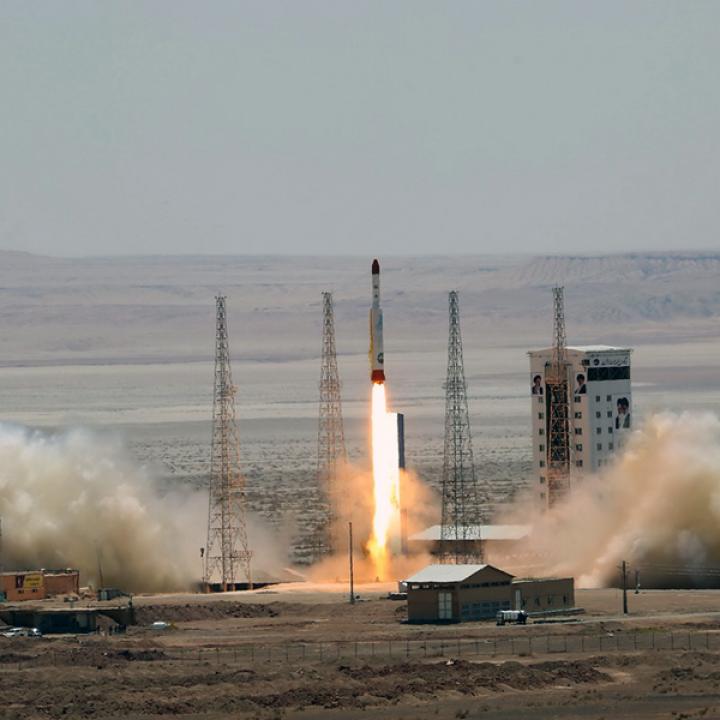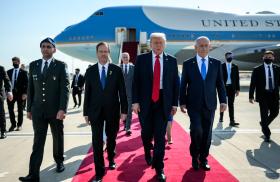
- Policy Analysis
- PolicyWatch 2839
Iran's Space Program Emerges from Dormancy

The reported failure of the July 27 launch offers little solace to Western observers, since it likely anticipates future attempts as well as the potential for more-advanced technologies.
According to a news report citing a U.S. Strategic Command initial assessment, Iran's attempt to place its first operational satellite into orbit on July 27 using a Simorgh space launch vehicle (SLV) experienced catastrophic failure shortly after liftoff. The case marks the first Iranian acknowledgment of launching the heavy SLV, operating from its new permanent launch site, known as the Imam Khomeini National Space Center (IKNSC), located 220 kilometers southeast of Tehran in Semnan province.
Yet this was not, in fact, Iran's first actual attempt to launch a Simorgh -- a rocket unveiled in 2010 and named for a mythical bird. That first effort took place in April 2016, also out of IKNSC, but was kept a secret and described by U.S. intelligence sources as "partly successful" although not intended for satellite orbital insertion. Russian sources indicated differently, claiming it to be a successful suborbital test of the new rocket. The evidence here is instructive, showing that on March 15, 2016, Manouchehr Manteghi, who heads Iran's National Space Center -- part of a confusing web of space agencies -- had laid out a plan whereby the first attempt to place an operational satellite into orbit using a Simorgh, scheduled for February 2017, would be preceded by two test launches without payloads, in spring and autumn 2016. Taking the Iranian official's statement at face value, one would expect the first attempted launch of an already-delayed operational Simorgh within months.
Iranian officials, despite the findings of U.S. intelligence, declared the recent launch a success, thereby evidently laying the groundwork for future Simorgh launches with satellites as heavy as 250 kilograms into a longer-lasting 500-kilometer low earth orbit. Bearing this weight would mark a fivefold increase from the previous-generation Iranian Safir SLV, for which four successful -- and several unsuccessful -- launches are on record. According to Manteghi, though, the current Simorgh generation can handle only a 100-kilogram payload at that orbit.
The Simorgh, more technically, is a two-stage, twenty-six-meter-long, 145-ton-thrust rocket, with an actual weight of 85 tons. Its configuration resembles that of the North Korean Unha SLV, which has assembled a record of three failed and two successful launches between 2006 and today, the last of which reportedly occurred February 7, 2016. The Simorgh's first stage has four Shahab-3 liquid-fuel engines, compared to Safir's one such engine. Indeed Iran's liquid-fuel engine technology still relies heavily on old Russian Scud/North Korean Nodong technology.
The IKNSC, Iran's first permanent SLV site, was completed in 2013, following a hasty period of construction. It was reportedly designed and built with foreign -- possibly North Korean -- help and is managed by the Sairan space group, a subsidiary of Iran's Ministry of Defense. Initially, Chabahar, located on the coast of the Oman Gulf, was identified as the most suitable location, given its proximity to the equator, but the Semnan military region was eventually chosen for "logistical" reasons. Thus, the 1,300-kilometer distance between IKNSC and the nearest Iranian coastal waters reduces the possibility that foreign navies could recover fallen rocket parts, but it likewise increases the risk of debris landing on civilian areas.
Potential Military Dimensions
An SLV incorporates many common technologies with intercontinental ballistic missiles (ICBMs), and a Simorgh-type ballistic missile is estimated by rocket engineers to have a 7,500-kilometer range with a 700-kilogram warhead. This range falls short of the continental United States but covers all Europe and Asia. Thanks to its Kavoshgar rockets, Iran also has experience with reentry vehicles.
A rule of thumb in rocket science holds that, while solid-fuel motors provide higher thrust at a lower cost, liquid-fuel engines are more efficient and can offer more control along the entire chosen trajectory. The advantages of solid-propellant technology -- alongside recent North Korean successes in the field and the prospect of greater Tehran-Pyongyang cooperation -- elevate it as Tehran's preference. Still, given Iran's experience working on the liquid-fuel Simorgh, one can never entirely dismiss the possibility that Tehran would pursue the liquid-fuel path if it chooses to build an ICBM.
Satellite Momentum
For the time being, Iran appears to be focused on using the Simorgh and possibly the Safir to launch one or two satellites into orbit by March 2018, with two or three further launches expected during the following year. The first satellite scheduled for launch atop the Simorgh is called the Toloe-1 ("dawn"), an experimental remote-sensing and communication satellite weighing 100 kilograms -- Iran's heaviest to date -- and equipped with a 25-meter resolution camera. In ultimately seeking to produce an operational geosynchronous (36,000 kilometer) telecommunications satellite for both civilian and military applications, the Iranian Defense Ministry and Iranian universities have been readying a number of experimental models for launch. But this ambitious goal will require more powerful SLVs -- e.g., the reported Qaem -- with reliable upper stages to carry a satellite to its final higher orbit.
In 2016, Iran unveiled its first orbital upper-stage Saman-1, said to have been designed for placing a piggybacking 100-kilogram satellite into a 400-by-700-kilometer low-elliptical orbit. Success here and in future geosynchronous orbital insertions will indicate improvements in Iran's orbital maneuvering and propulsion, precise positioning, trajectory computation, and subsystem reliability. All these competencies will be useful if the Islamic Republic chooses to develop ICBM reentry vehicles.
For years, Iran has appeared determined to develop or acquire technologies required for geosynchronous satellite operations. In February 2017, for example, Iran unveiled the 50-kilogram Nahid-1 test-bed satellite to experiment with Ku-band communication and folding solar panels; set for later is the Nahid-2, at twice the weight. Launch schedules are not yet known for either satellite. More recently, Iranian officials have indicated greater interest in microsatellites at lower orbits, possibly to cut cost and lead times.
Although the most recent Simorgh launch was not said to carry any satellite into orbit, the crucial question is what this capability -- if fully operationalized -- could mean in a wider context. The future appearance of more powerful and reliable boosters, an objective hinted at in 2016 by Defense Minister Hossein Dehghan, will stir suspicions that Iran plans to divert related technologies for purely military programs and even an eventual ICBM capability.
Manned Space Aspirations Tabled
During Mahmoud Ahmadinejad's presidency (2005-13), the Iranian Space Agency considered launching a human into orbit in a specially designed capsule -- but the estimated initial $8.5 billion cost, including astronaut training in Russia, proved prohibitive. In addition, frequent organizational reshuffles reportedly spurred confusion and frustration among the lower cadres, reportedly leading to brain drain.
In recent months, however, Iranian Space Agency officials disclosed an unofficial halt to their manned space project, citing a lack of funding -- likely alongside organizational, and technical explanations -- and their decision to instead focus on the SLV projects. Such a pause makes sense given the daunting task of placing a manned spacecraft into low earth orbit, not to mention a hefty $15-20 billion budget.
Whatever the vacillations between manned spaceflight and SLV emphasis, all such major aspects of Iran's space program are authorized and guided over the long term by a Supreme Space Council, which reports to the Supreme Leader, Ayatollah Ali Khamenei. As a result, such initiatives cannot simply be "halted" or "stalled" by mere government officials, despite claims to the contrary by the hardline media, unless such officials want to risk incurring Khamenei's displeasure. The latest official comments, published July 28, suggest Khamenei has ordered a blocking of President Hassan Rouhani's attempts to decentralize the Iranian Space Agency, which during Ahmadinejad's time was under direct presidential control.
Further regressions toward the Ahmadinejad era could occur with any continued success of the Simorgh, or further availability of funds. In particular, on January 8, 2013, Ahmadinejad's government published an official strategic "roadmap to 2025," reportedly 40,000 pages in length. Only 14 pages have been made public, but these envisage the design and launch of SLVs and satellites, including military-operated imaging satellites. The same document also called for an effective missile deterrence.
Depending on funding and launch capability, satellites even larger than the 250-kilogram examples (around the maximum weight a prospective Simorgh-2 could carry) might emerge in the longer term. Perhaps the most striking development on this front, however, would be the direct entry into -- or takeover of -- Iranian satellite design and launch programs by the Islamic Revolutionary Guard Corps, an idea recently alluded to by an IRGC commander. This would mark a full reversal of Iran's at least superficially civilian space program.
Conclusion
With this latest launch, Iran's space program has emerged from a three-year dormancy initiated by Rouhani but probably issuing from technical and budgetary constraints as well. Further launches can be expected in the near future, likely renewing concerns over the nature of Iran's missile and SLV programs. The scenario is especially worrisome when considering assessments that a ballistic-missile derivative of the Simorgh could potentially achieve intercontinental range. Iran insists its inherently military-run space program is for peaceful purposes only and that its ballistic missiles are for conventional deterrence at a range no greater than 2,000 kilometers. Such rhetoric and Iran's technical limitations notwithstanding, the mere possibility of diverted know-how from an SLV to an ICBM program will unsettle many Western capitals. Previous close cooperation between Tehran and Pyongyang will provide no further solace.
Farzin Nadimi is a Washington-based analyst specializing in the security and defense affairs of Iran and the Persian Gulf region.



